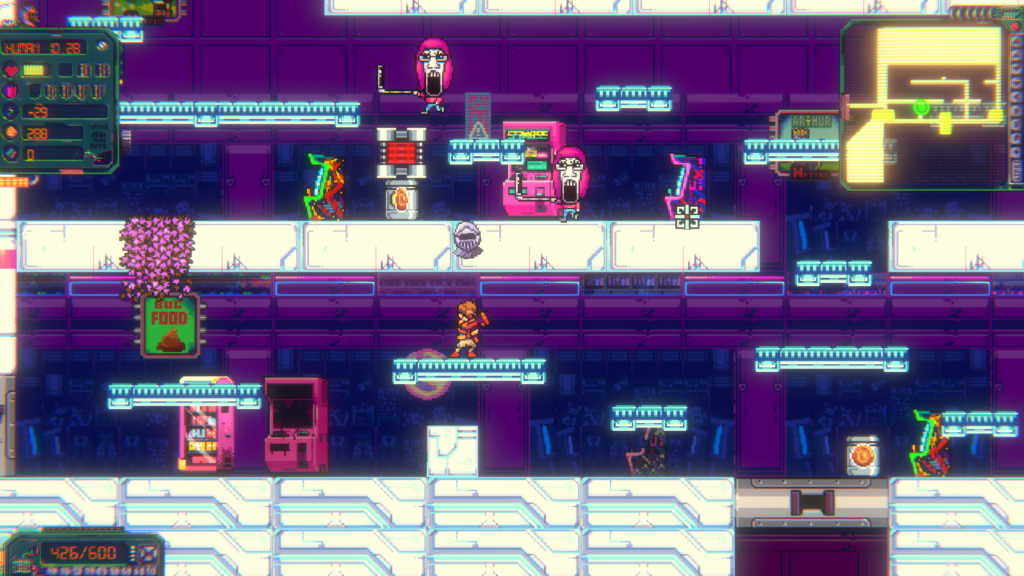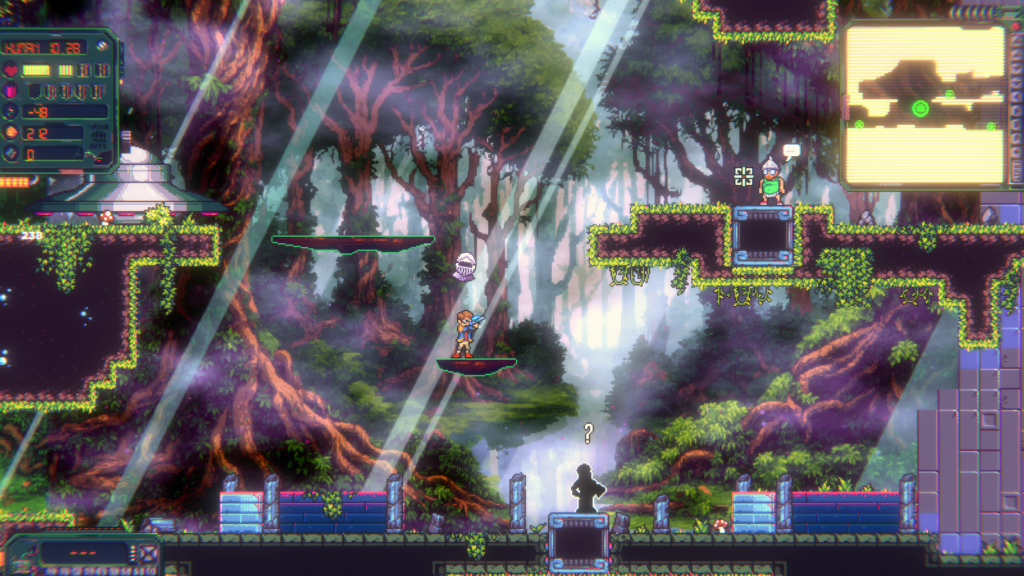The Great Rebellion
Kvltgames, the developer which released the first identitarian video game, Heimat Defender, has just released a sequel. The company is led by the former Austrian identitarian activist Roland Moritz. Like its predecessor, The Great Rebellion follows the story of a man fighting an oppressive corporation, which is now called Lucis Lux. This global corporation has reduced Europe to a homogeneous mass of mindless drones, with every aspect of their lives kept under surveillance — even their dreams. This much power is not enough for them, however, and they plan to soon “remove the human factor from the equation entirely.” Our hero, Human 10.28, has seen through the shallow existence provided by the corporation and tears out his implanted tracking chip, declaring war on the oligarchs.
When the game begins, the player encounters a computer terminal which provides more information on the world in which he finds himself. The options available here show the extremely limited life permitted to corporate subjects. Saving money is illegal; the only products available to consume are food, clothes, video games, and porn; and the corporation decides which varieties of each of them are appropriate for each subject. Based on the player’s pornography consumption, the corporation has judged your taste in women to be “yikes,” and has chosen to correct it by “downloading two terabytes of plus-sized homosexual porn to your smart phone.” Your “live medical data” will be analyzed to confirm that you have consumed it.
The player is soon informed that he has been replaced at his job by the latest variety of genetically-altered worker, and that his bank account has been shut down. A guard informs him that he must be “educated” or exterminated, as he has violated the corporation’s community standards. Luckily, he is rescued at this point by the appearance of a blonde woman by the name of Europa.
Europa whisks the hero away to a safer location called the Waldgang, an area of wilderness where she further instructs him on how to play the game. This includes combat — which, in line with the development company’s CEO’s former activism, is entirely non-lethal — using weapons that only harm the corporation’s artificial creations, liberating the Europeans trapped inside. He can be assisted in combat by the spirits of mythological and historical European heroes such as King Arthur and Charles Martel — although as Europa points out, they are out of practice, since Europeans have forgotten about them in recent years.
The enemies in the game include a variety of strange robots which for the most part resemble nothing in the real world, or even in memes. There are also creatures called “Consoomers” who were once like us, but “have been twisted by their constant connection” to social media. These take the form of the familiar bearded, open-mouthed “soyjacks” carrying smartphones. There are also female versions with selfie sticks, and both are equally disturbing. The game cannot be accused of not respecting gender equality.

One level of the game offers a terrifying vision of people who have been transformed by social media.

You can buy Greg Johnson’s It’s Okay to Be White here.
Each level ends with a one-on-one duel with a particularly powerful enemy, one of which is apparently based on the sizeable black vocalist Lizzo. The “Yass Queen,” as she is known, has no recognizable weapons, but carries a microphone and emits “damaging frequencies” by twerking. This is presumably a warning about the dangers of obesity and low-quality pop music, two of the most prevalent health problems in our current year. Another boss, called The Transitioner, is based on a familiar photograph of a drag queen in a demon costume reading to children. Hopefully neither of their real-life counterparts have very aggressive lawyers.
Similar to Kvltgames’ previous release, The Great Rebellion employs a synthwave aesthetic for both its music and graphics. There is a particularly beautiful vocal track that was recorded by the composer RetroRebel and is used in the game’s introduction. Throughout the rest of the game, electronic music is dynamically altered to fit the level of action at the moment. Pink, purple, and blue are everywhere in the cities where much of the action takes place, as well as in the Waldgang, where the player returns after every level for relaxation and various upgrades. This is largely an action game of the “run and gun” variety, with side-scrolling graphics similar to early 1990s games such as Duke Nukem 2, although with higher resolution and more advanced animation than were possible at that time. One very unusual feature is the ability to apply effects which simulate the graphics of more primitive gaming systems, such as those which used CRT (cathode ray tube) displays. There are five such options, including one in which the colors are mostly in shades of green, although these obscure the impressive attention to detail in the game’s visual aesthetics.
This game has also been classified as a “roguelike,” a term referring to the 1980 role-playing game Rogue, which featured procedurally generated rather than manually designed levels. Unlike Rogue, however, the player can choose the “affirmative action” setting so that he can never permanently die. When killed, his character will simply return to the Waldgang, where he will have the chance to purchase further upgrades and make another attempt at the “same” level — one similar in setting and enemies, but in a new, randomized arrangement. This alleviates the frustration experienced by players of many earlier games, where having difficulty in getting past a particular level could mean a great deal of repetition.

The hero meets with various friendly characters in the Waldgang who offer upgrades and plot exposition.
As the player progresses, his social credit score, which starts at zero, goes into negative numbers. The lower the score, the better the upgrades he can afford to purchase in the Waldgang between levels. In other words, the more the authorities despise you, the more you develop your capacity to fight back. There are also friendly characters who can be found throughout the levels and who then appear in the Waldgang to offer you various services. One of these paraphrases lines from the book Nihilism by the late Orthodox monk Seraphim Rose, while offering you a blessing. Blessings are “strongly discouraged” by the corporation, so this further reduces your social credit score.
The previous game was removed from Steam under pressure from the German Federal Criminal Police (BKA), and was added to the List of Youth-Endangering Media by the Federal Department for Media Harmful to Young Persons (BPjM), which makes it illegal to advertise in Germany. Lawyers for the dissident organization which provided funding for the game advise that even mentioning its name could be dangerous. Sympathetic commentators have thus felt compelled to use euphemisms such as Country of Origin Protector. Someone has already written a Master’s thesis on the subject of “radicalization through video games,” complaining that it makes globalist figures and trans people targets for “hatred.” The BPjM, for its part, contends in its official justification of its decision that since some of the enemies in the game carry rainbow flags, it promotes discrimination against “queer people.”
Unlike Heimat Defender, the player does not assume the role of any real-world activist, nor are there any references to specific identitarian literature. Although there are still references to figures such as The Golden One and Martin Sellner, the present game “reduces the amount of right-wing scene fan service,” as the developer puts it, and if there are any rainbow flags, I have not seen them. As with its predecessor, the “violence” does not involve actually killing anyone and can hardly be seen as motivated by hatred. At least one man appears in the Waldgang to thank the hero for liberating him by destroying his robot shell. The game indeed promotes European identity, however, which is presumably enough to qualify it as dangerous for youth. So far it has not been removed from Steam, but it remains to be seen whether The Great Rebellion will be treated in the same way as Heimat Defender.
The developer’s stated goal is to develop a Right-wing gaming scene which can compete with the decadent “AAA games”: well-known titles with enormous budgets and credits which run for 45 minutes, but which lack substance. Dissident ideas are often translated into entertainment as a sort of gimmick, with the ideology taking precedence over creative considerations, and he says that he aims to produce something more professional. He has been successful in terms of the present game. Hopefully Kvltgames will be able to continue along these lines well into the future.




